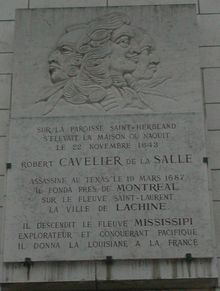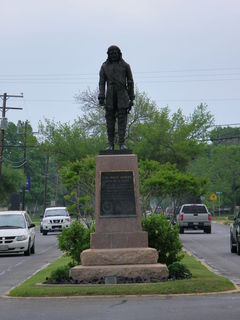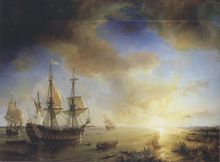| René-Robert Cavelier | |
|---|---|
 A 19th-century engraving of Cavelier de La Salle | |
| Born | November 21, 1643 Rouen, Normandy, France |
| Died | March 19, 1686 (aged 42) present day Huntsville, Texas |
| Nationality | French |
| Occupation | explorer |
| Known for | exploring the Great Lakes, Mississippi River, and the Gulf of Mexico |
| Signature | |
 | |

René-Robert Cavelier, Sieur de La Salle, or Robert de LaSalle (November 21, 1643 – March 19, 1687) was a French explorer. He explored the Great Lakes region of the United States and Canada, the Mississippi River, and the Gulf of Mexico. La Salle claimed the entire Mississippi River basin for France.
Biography
Youth
La Salle was born on November 21, 1643, in Rouen, France.[1] As a young man, he studied with the Jesuit religious order, and became a member after taking his vows in 1660. On March 27, 1667 at his request, he was released from the Society of Jesus after citing "moral weaknesses".[2] Although he left the order and later became hostile to it, histories sometimes described him incorrectly as a priest or a cleric.
Marriage and family
He married Danielle Armbrecht and they had several children.
Career
Required to reject his father's legacy when he joined the Jesuits, La Salle was nearly destitute when he traveled as a prospective colonist to North America. He sailed for Canada in the spring of 1666.[3] His brother Jean, a Sulpician priest, had moved there the year before. La Salle was granted a seigneurie on land at the western end of the Island of Montreal, which became known as Lachine.[4] (This was apparently from the French la Chine, meaning China. Some sources say the name referred to La Salle's desire to find a route to China, though the evidence for this claim is unclear and has been disputed).
La Salle immediately began to issue land grants, set up a village and learn the languages of the native peoples, mostly Mohawk in this area. The Mohawk told him of a great river, called the Ohio, which flowed into the Mississippi River. Thinking the river flowed into the Gulf of Mexico, La Salle began to plan for expeditions to find a western passage to China. He sought and received permission from Governor Daniel Courcelle and Intendant Jean Talon to embark on the enterprise. He sold his interests in Lachine to finance the venture.[5]
First expedition
La Salle led an expedition in 1669 in which he reached the Ohio River and followed it downstream to as far as what is now Louisville, Kentucky. The falls there prevented his continuing further.[6] It was not until 1672 that Louis Jolliet and Père (Father) Jacques Marquette explored the upper deck.[7] La Salle later participated in an expedition to follow the northern shore of Lake Erie to Michilimackinac. His group had 12 men in five canoes. Père Francois Dollier de Casson traveled with La Salle as far as Hamilton, Ontario with seven men in another three canoes. There the party met Joliet's brother, who was returning to Montreal. On his advice, they went on to what is now known as Sault Ste. Marie to establish a mission to the Potawatomi. They were unsuccessful.
Fort Frontenac
La Salle oversaw the building of Fort Frontenac (now Kingston, Ontario) on Lake Ontario as part of a fur trade venture. Completed in 1673, the fort was named for La Salle's patron, Louis de Buade de Frontenac, Governor General of New France. La Salle traveled to France early the next year to establish his claim and to procure royal support. With Frontenac's support, he received not only a fur trade concession, with permission to establish frontier forts, but also a title of nobility. He returned and rebuilt Frontenac in stone. Henri de Tonti joined his explorations. An Ontario Heritage Trust plaque describes René-Robert Cavelier de La Salle at Cataracoui as "[a] major figure in the expansion of the French fur trade into the Lake Ontario region, La Salle (1643-1687) was placed in command of Fort Frontenac in 1673. Using the fort as a base, he undertook expeditions to the west and southwest in the interest of developing a vast fur-trading empire." [8]
Le Griffon and Fort Wayne
On August 7, 1679, La Salle set sail on the ship Le Griffon, which he and Tonti had constructed on the upper Niagara River. At Fort Conti, which they had built at the mouth of the Niagara River and Lake Ontario a few months earlier, they shifted supplies and materials brought from Fort Frontenac into smaller boats, canoes or bateaux. They wanted to be able to travel up the lower part of the shallow Niagara River, to what is now the location of Lewiston, New York. The Iroquois had a well-established portage route in the area which they used to avoid the rapids and the cataract later known as Niagara Falls.
La Salle used Le Griffon to sail up Lake Erie to Lake Huron, then up Huron to Michilimackinac and on to present-day Green Bay, Wisconsin. La Salle then departed with his men in canoes down the western shore of Lake Michigan. In January 1680, La Salle's men built a stockade at the mouth of the Miami River (now St. Joseph River. They called it Fort Miami (now known as St. Joseph, Michigan.) There they waited for Tonti and his party, who had crossed the peninsula on foot.
Tonti arrived on November 20; on December 3, the entire party set off up the St. Joseph, which they followed until they had to take a portage at present-day South Bend, Indiana. They crossed to the Kankakee River and followed it to the Illinois River. There they built Fort Crèvecoeur, which later led to the development of present-day Peoria, Illinois. La Salle set off on foot for Fort Frontenac for supplies. While he was gone, Louis Hennepin followed the Illinois River to its junction with the Mississippi. La Salle was captured by a Sioux war party and carried off to Minnesota.[citation needed] The soldiers at Ft. Crevecoeur mutinied, destroyed the fort, and exiled Tonti, whom La Salle had left in charge.[9] Later La Salle captured the mutineers on Lake Ontario. He eventually rendezvoused with Tonti at St. Ignace, Michigan.
Final expeditions
La Salle reassembled a party for another major expedition. In 1682 he departed from present-day Fort Wayne with 18 Native Americans and canoed down the Mississippi River. He named the Mississippi basin La Louisiane[10] in honor of Louis XIV and claimed it for France. At what later became the site of Memphis, Tennessee, La Salle built the small Fort Prudhomme. On April 9, 1682 at the mouth of the Mississippi River near modern Venice, Louisiana, La Salle buried an engraved plate and a cross, claiming the territory for France.
In 1683, on his return voyage, La Salle established Fort Saint Louis of Illinois, at Starved Rock on the Illinois River, to replace Fort Crevecoeur. He appointed Tonti to command the fort while La Salle traveled to France for supplies. On July 24, 1684,[10] La Salle departed France and returned to America with a large expedition designed to establish a French colony on the Gulf of Mexico, at the mouth of the Mississippi River. They had four ships and 300 colonists. The expedition was plagued by pirates, hostile Indians, and poor navigation. One ship was lost to pirates in the West Indies, a second sank in the inlets of Matagorda Bay, and a third ran aground there. They founded Fort Saint Louis, on Garcitas Creek in Victoria County, Texas.[10] La Salle led a group eastward on foot on three occasions to try to locate the mouth of the Mississippi.

During another search for the Mississippi River, La Salle's remaining 36 men mutinied, near the site of present Navasota, Texas. On March 19, 1687, La Salle was slain by Pierre Duhaut during an ambush while talking to Duhaut's decoy, Jean L'Archevêque. They were "six leagues" from the westernmost village of the Hasinai (Tejas) Indians.[10]
The colony lasted only until 1688, when Karankawa-speaking Indians killed the 20 remaining adults and took five children as captives. Tonti sent out search missions in 1689 when he learned of the settlers' fate, but failed to find survivors.[citation needed]
There is some disagreement about accepting Navasota as the site of La Salle's death. The historian Robert Weddle, for example, believes that La Salle's travel distances have been miscalculated. Weddle thinks that La Salle was murdered just east of the Trinity River, which would put the site somewhere about 20 miles (32 km) east or east-northeast of today's Huntsville, Texas.[citation needed]
Legacy

In 1995, La Salle's primary ship La Belle was discovered in the muck of Matagorda Bay. It has been the subject of archeological research.[11][12] Through an international treaty, the artifacts excavated from La Belle are owned by France and held-in-trust by the Texas Historical Commission. The collection is held by the Corpus Christi Museum of Science and History. Artifacts from La Belle are shown at nine museums across Texas. The wreckage of La Salle's ship L'Aimable has yet to be located. The possible shipwreck of Le Griffon in Lake Michigan is the subject of a lawsuit concerning ownership of the artifacts.
- Many places were named in La Salle's honor, as was the LaSalle automobile brand. (see La Salle and the Tribute section for a list of places, most of which were named after him).
- Fort LaSalle at the Royal Military College of Canada in Kingston, Ontario
- LaSalle, in Essex County, Ontario, south of Windsor on the Detroit River
- Ville Lasalle is a borough of the city of Montreal, Quebec, Canada.
- Avenue La Salle, located in Shawinigan, Quebec, Canada.
- Lasalle Road, a prominent east-west road to the south of Sarnia, Ontario, Canada.
- LaSalle County, Illinois and the town of LaSalle within it.
- LaSalle-Peru Township High School LaSalle, Illinois has the mascot of the Cavaliers (Cavs) and Lady Cavaliers (Lady Cavs).
- La Salle Street in Navasota, Texas. It also contains a statue given by the French Government in honor of the explorer.
- La Salle Avenue, a prominent downtown street in Minneapolis, Minnesota.
- The La Salle Expressway, a prominent roadway through Niagara Falls, New York and its outer suburbs.
- LaSalle Street, a major north-south thoroughfare in Chicago, leads directly to the Board of Trade, and is the center of Chicago's financial district.
- LaSalle Park - Burlington, Ontario
- Jardin Cavelier de La Salle in the 6ème arrondissement in Paris
- La Salle Hotel in downtown Bryan, TX
- The La Salle Causeway, connecting Kingston, Ontario to neighbouring Barriefield, Ontario.
- La Salle Hotel, Chicago[13]


No comments:
Post a Comment